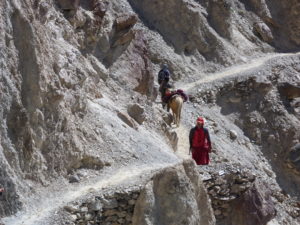
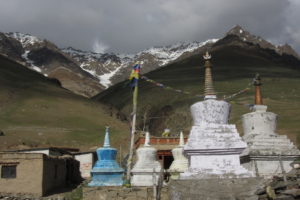
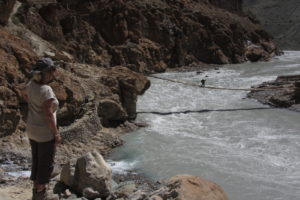
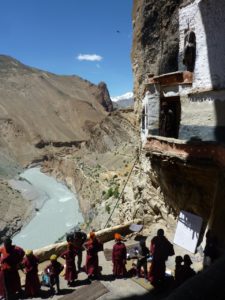
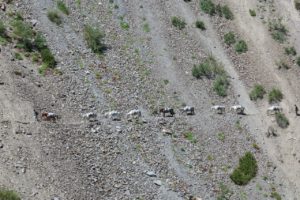
+91-9419333393
cwangdus@gmail.com
Do not hesitate to give us a call. We are an expert team and we are happy to talk to you.
+91-9419333393, +91-9469867272, +91-(0)1982- 255223
cwangdus@gmail.com





Duration : 19 Days
Grade : Moderate+
Zanskar, one of the world’s remotest region is famous for its arid lunar landscapes and the centuries old tibetan buddhist culture. Trek up and down seven passes, scenic valleys, village dotted meadows and far-flung monasteries which occupy spectacular fortified locations, high on rocky ridges surrounding the valleys. A must-do for adventure buffs.
A great trek to explore Zanskar, one of world’s remotest regions, famous for its arid lunar landscape and centuries old Tibetan Buddhist culture, still practiced in its purest form than perhaps anywhere else on earth. The challenging route takes us up and down seven passes, often as steep zig zags offering panoramic view points and across scenic lush deep valleys and meadows dotted by villages and settlements. The archaic form of Tibetan Buddhism flourishes in a chain of far-flung monasteries most of which occupy spectacular fortified locations, high on rocky ridges surrounding the valleys. Most notable of these is the Lamayuru monastery at 3510m – one of the oldest in Ladakh. Other cultural highlights include Lingshid, Karsha, Pishu, Rangdum, Padum – capital of Zanskar and Kargil.
NOTE:- All the itineraries can be customized to suit your own special interests, preferences, abilities, extension and reduction of numbers of days.
Our services start with your arrival at Leh airport. Meet & greet and transfer to the Hotel. Welcome drink on arrival. We recommend you completely relax for the rest of the day to enable yourselves to acclimatize to the rarefied air at the high altitudeanda successful trek in Ladakh requires you to acclimatize well with high altitude, tourist can explore the Leh market and shanti stupa in the evening only if you feel fine. O/N hotel
Today we do the local exploration, visiting the local market of Leh. Then, we visit Shanti Stupa which is a Buddhist white-domed stupa (chorten) on a hilltop in Chanspa, in the north Indian state of Jammu and Kashmir. This was built by Japanese monks to promote world peace. The Shanti Stupa holds the relics, enshrined by the 14th Dalai Lama himself. Later we visit Leh Palace, nine storey palace built in 1553. One can have the beautiful view of Leh city and surrounding mountains. Afterwards proceed to Sankar Gompa which is located at 3 kilometers distance from Leh, it is a subsidiary of Spituk Monastery and belongs to the Gelugpa Sect. The Gompa is also the residence of Kushok Bakul . We also visit Namgyal Tsemo Monastery perched on a hilltop from where we have a bird’s-eye view of the Leh city. The Gompa has a three-storey high solid gold statue of Matireya Buddha and ancient manuscripts and frescoes. It was built in 15th century by King Tashi Namgyal; after that we come back to hotel and relax. O/N hotel
The Hemis Monastery located around 45 km south of Leh is one of the largest and most famous monastery of Ladakh and belonging to the Drukpa Kagyu. The monastery houses an amazing collection of the age-old relics such as the idol of Lord Buddha made up of copper gilt, gold and silver stupas and revered thangkas, making it one of the richest monasteries in Ladakh. The monastery founded by the first incarnation Stagsang Raspa Nawang Gyatso in 1630, and when it was named Changchub Samling.
Continuation of the visit of the high valley of the Indus and its monasteries. It takes 40 minute driving up to reach the beautiful village of Thiksey ( Founded in 1433 by Palden Sherab), dominated by an imposing Gelugpa monastery . This Thiksey monastery majestically overlooks the valley, a magnificent group of about 80 monks; discovery of the beautiful inner courtyard which distributes access to the various temples. The most amazing is certainly the temple of future Buddha with its gigantic interior statue which covers all floors of the building. To join the next site, we will take the path of school children. Start on foot from the monastery of Thikse following small roads that cross the fields. It is possible to find the vehicles after 45 minutes of walking or drive to Shey (Built in 17th century by king Deldan Namgyal). Shey ancient capital of Ladakh , is an interesting complex whose importance is still measured by the quality of the paintings and the astonishing quantity of chortens or other votive monuments that surround it. The Rock-carved statue of five Buddha can be seen below the palace on the roadside, which was probably carved during the reign of Singay Namgyal. O/N hotel
In the morning after breakfast we leave Leh and drive towards Lamaoyuru via visiting Alchi temple renowned as the oldest Buddhist learning centre, the Alchi Gompa is one of the magnificently built monasteries in Ladakh. Located 70 kilometres west of Leh on the banks of the Indus River, it is also the largest and most famous of the gompas built by Tibetan translator Rinchen Zangpo in 11th century. Continue drive to Lamayuru monastery, which is one of the oldest and largest monasteries in Ladakh region. Arahat Nimagon blessed the site and Mahasiddha Naropa found the monastery in the 11th century, Lamayouru is famous for its rich collections of thangkas, murals, scriptures and statues of different forms of Buddha and other deities. Later we head towards the campsite. O/N camp
Wanla en-route cross Prinkiti La (3750m) This morning we have breakfast and begin our trek towards the campsite of Wanla; the trail leads us downwards from where we follow a stream and then we start ascending to the top of Prinkiti La (3750m) after crossing the pass we descend towards a gorge from where we walk up to the Shillakung valley. Then we cross the river and walk further on the trail that will take us to the village of Wanla. O/N camp
Today at the beginning we will be crossing a river and then keep on walking along the road until we reach at the spot where the trail splits into two: one goes to Zanskar valley and the other one goes to Ripchar valley. We follow the main trail along the river, later cross the river by bridge and we head towards a gorge which is very dangerous for ponies. A little further we walk and reach to the village of Hanupatta. O/N camp
After breakfast we start a gentle walk through the village towards Mani wall and Chortens then the trail is a steep ascend towards the pass of Sirsir La (4850m). We reach the pass from where we can see the next pass Singge La (5050m) and the magnificent view of Zanskar mountains range. Then the trail descends towards a small village of Photoksar our next campsite for the night. O/N camp
We start our morning with heavy breakfast and continue our walk; the trail goes up to the pass of Bumiktse La (4200m); cross the pass then we descend to a beautiful valley. We keep on walking as the trail is gentle for now and we enjoy the scenic view of the valley and its village as well as the green fields. Then we start climbing a steep section that will take us to the pass of Singge La (5050m Singgey La means Lion’s pass and this is the highest pass on this trek); from the pass we will be blessed again with a stunning view of Zanskar mountains range; then we descent all the way down towards our next campsite that is the base of Singgey La where we camp for the night. O/N camp
This morning after breakfast we continue our walk towards a village of Lingshed (3800m); we head towards a small pass of Kyukpa La (3850m); we cross the pass and descent towards the villages of Gongma and Skyumpata. Again we cross another pass Morgon La (4100m) from here the trail is a gentle walk towards the beautiful village of Lingshed our next campsite, it has a very old Lingshed monastery which belongs to Gelugpa order. O/N camp
Today after finishing breakfast we follow the trail beside the stream and then a gradual ascent to the pass of Hanuma La (4700m) from here we can watch the Lingshed monastery and then we descent through narrow valleys to the meadows of Snertse village the campsite for the night. O/N camp
Morning we finish breakfast then start trekking to the trail that goes upwards for sometimes then we reach Zingchan where we cross the river Oma Chu through the bridge. Now we start a steep ascent towards the pass of Barfi La (3950m) then we cross the pass by descending to the Zanskar River from here the trail is easy walk to reach the village of Hanumil where we camp for the night. O/N camp
This day after breakfast we trek towards Pishu village our next campsite; we walk along the right side of Zanskar River and reach village of Pidmo, here we cross a bridge and carry on walking on the trail that would lead us towards our campsite, Pishu village. O/N camp
Today morning after breakfast we may possibly do a tour to watch the longest hanging bridge on the Zanskar River which leads to Zangla. Then we move on towards Karsha village through the hot and dusty trail beside the Zanskar River en-route we cross Rinam village. Reach Karsha village our campsite for the night; here one can visit the famous monastery of Zanskar region, Karsha monastery. Karsha monastery is located on the hilltop with a magnificent view of the valley and belongs to the Gelugpa order. O/N camp
Morning we finish breakfast and leave Karsha village; on the way we cross Doda River through a bridge and head towards Pipiting, visit the monastery and finally we reach Padum known for its scenic beauty and serves as the capital for Zanskar region. (Trek ends ) O/N camp
Today early morning we have breakfast and drive towards Rangdum via visiting Sani monastery then The drive is challenging as the condition of road is not so good and after driving for some time the road goes upwards to the pass of Pensi La (4400m). Reach pass and enjoy the beauty of Mother Nature as we can watch Drang Drung glacier, Stat Tso and Lamtso . Then we continue our drive towards Rangdum, reach there and visit Rangdum monastery located on the hilltop and belongs to Gelugpa sect; later relax. O/N camp
Morning after breakfast we drive towards Kargil on the way we cross Parkachak and Panikhar villages which lies in the beautiful Suru valley. Kargil is the largest town in Ladakh after Leh; we reach Kargil and check-in to the hotel. O/N hotel
Morning after Breakfast leave for Leh, enroute visit Mulbek, Giant Living Buddha Sculpture on Rock Mountain, The Wakha–Mulbekh Valley looks like a calm grass-green sea over which a vast tsunami of frothing red mountains is about to crash. It’s breathtaking at sunset, especially when viewed from the former castle site. Drive continue to leh via driving through Fotu la (3520m) and reach leh by evening . O/N hotel
Free time for personal activities. O/N hotel
Early morning transfer to Leh airport to board flight back to destination. Journey Ends with sweets memories.
For the more adventurous a drive to either Manali or Srinagar can also be arranged on request. The road journey is covered in two or more days with an overnight halt at either Sarchu or Jispa, which lies on the Leh-Manali highway, or Kargil, which lies on the Leh-Srinagar highway.
Pay heed to the guidelines given by trek leader or instructor in order to enjoy a safe and sound trekking experience.
Avoid trekking during the nights. Single rooms and tents can be requested for a supplement (subject to availability). Please enquire at the time of booking.
Ladakh is very safe, tourist friendly and cheering place, but still you need to take care of some preparations which can make your tour even better and memorable: Carry headache, stomachache, anti-vomiting tablets with you. Please respect the culture of Ladakh. We are providing world class services in the secluded place, which is similar to an oasis, is very difficult and challenging. Still we try our best to bring cheer on your faces.
Code of Ethics for tourists visiting Ladakh
a. As a Guest – Respect local traditions- protect local cultural- maintain local prides.
b. While taking Photographs- Respect privacy-ask permission and restraint use of flashlight for photography and filming inside National Monuments and smoking and alcohol drinking is strictly prohibited
c. Respect Holy Place- preserve what you have come to see- never touch or remove religious objects- purchase and sale of antiques which is more than 100 years old is against the law and it attracts punishment under rules.
d. Keep stream water clean and avoid using pollutants such as detergents in stream and springs- if no toilets facilities are available- make sure are at least 30 Meter away from water source and Bury or cover waste.
e. Giving to Children encourages begin- a donation to project like Health Centre or School is a more constructive way to help.
f. Visitors who value local traditions encourage local prides and maintain local cultures-please help them to gain a realistic view of life in other parts of the World.
g. The beauty of the place and loving kinds of the people may change you but please do not change them.
Eating and Drinking
Whilst camping, the staff will bring a hot drink (usually tea) to your tent each morning. When you reach camp in the afternoon tea and biscuits will be served. At breakfast, dinner and in the afternoons, there is a choice of hot drinks. Breakfasts typically include cereal, toast and jam, eggs and porridge. Lunch on trek is usually served as a picnic en route (except on shorter days when it is in camp). Lunch and dinner typically include soup to start, followed by a variety of hot dishes (both local and western) such as potatoes/chips, vegetables, curry, pasta, rice, dal and paneer (cottage cheese). At dinner time a dessert such as tinned fruit and custard, fritters or cake is also be served.
Note:- that although some meals will include meat, it is not as readily available while camping.
Drinking Water
Staying hydrated is important when undertaking any physical activity but particularly so at altitude where it is generally recommended to drink at least 3-4 litres per person per day.
We strongly encourage you not to buy bottled water as this contributes to the growing problem of plastic pollution in Ladakh. In Leh there is a shop called Dzomsa which sells safe drinking water. Your leader will show you where this is on your first day in Leh.
During the trek the cooks will collect and boil drinking water from the mountain streams and fill up your water bottles for you, but you may need to collect water during the day and may wish to use your own water purification treatment as well.
We also suggest that you may like to bring a reusable bottle with a wide opening (Nalgene or similar)
Weather
The above weather chart for Leh shows average temperatures only – it does not reflect extremes of heat and cold. Generally the weather is good in Ladakh during the summer time, with warm to very hot sunny days (up to 30ºC/35ºC+) with cooler nights depending on the altitude (it can reach freezing point at some higher places in September). There is, however, the possibility of rain, and you should be prepared for this. The sun is very strong at these altitudes and some of the days on trek can be extremely hot.
Ladakh, though technically part of the Tibetan plateau and classified as a high altitude desert, can and does occasionally experience the effects of the Indian monsoon. Although the departures are timed to coincide when the weather is normally good, you should remember that in any mountain area the weather is never wholly predictable and you should be prepared and equipped to deal with any differences in weather beyond the conditions described above.
Note:- While on a trek or expedition in a remote area if any client suffers from altitude sickness or any other serious injury, the sirdar/guide sends a runner to the nearest telephone/army post/road head to ask for help. Emergency evacuation becomes necessary in the following cases:High Altitude Sickness – If the client suffers from High Altitude Sickness, he/she needs to descend immediately. Injury – In case the client is badly injured – broken bones/fractures or sickness like thrombolysis (blood clotting), paralysis, loss of eyesight – in these cases as well he/she needs to be evacuated/descend immediately.
What to bring
Hiking trousers and shirts, warm jackets, pullovers and raincoat Good hiking shoes Flash light Sun hat/baseball cap Sunglasses, Lip balm Sun lotion cream and toiletries
